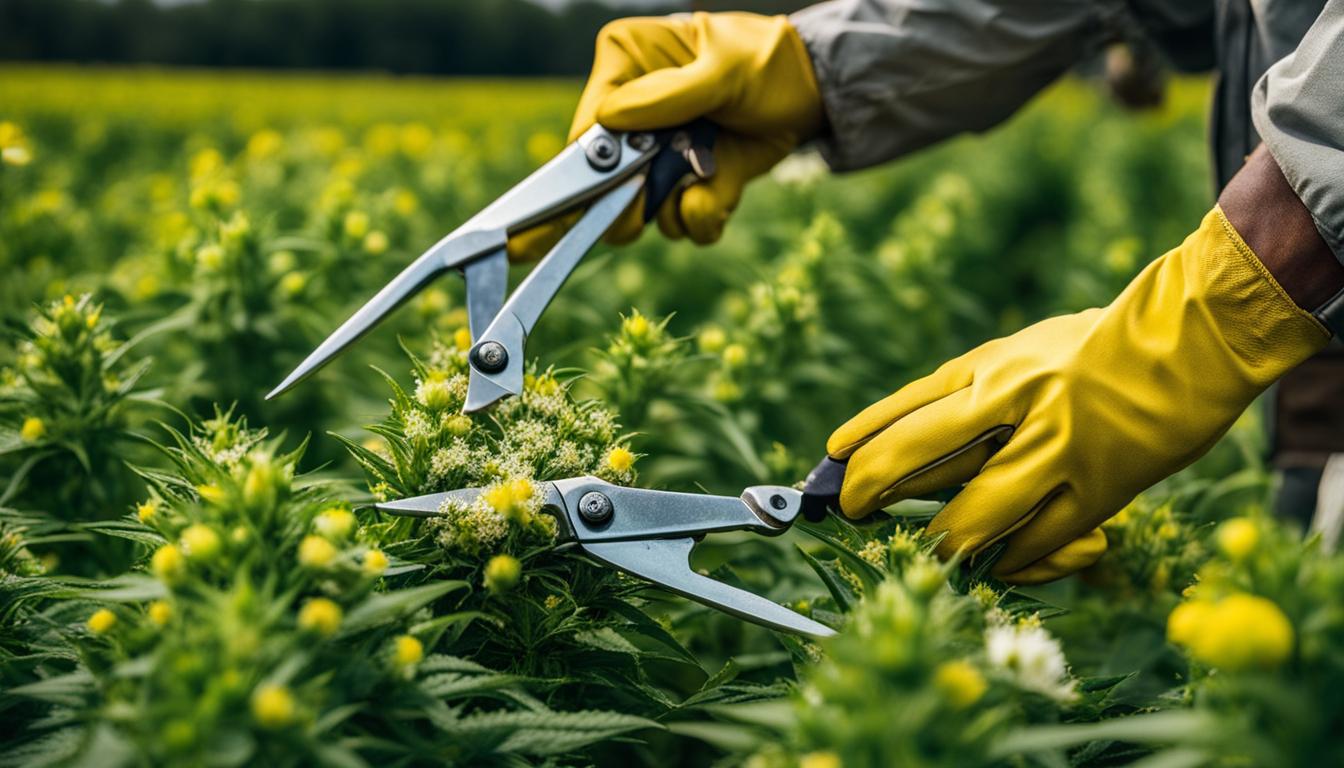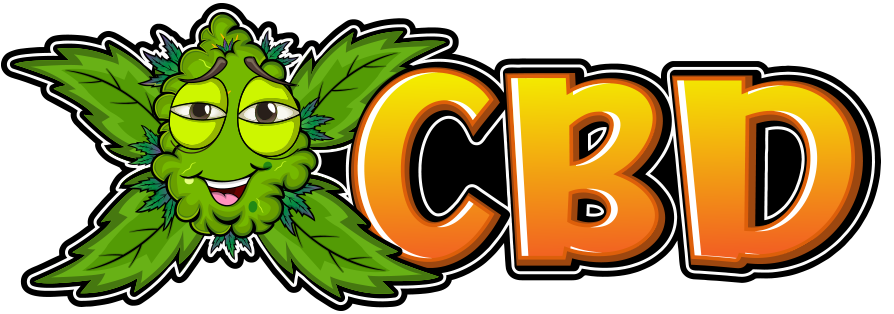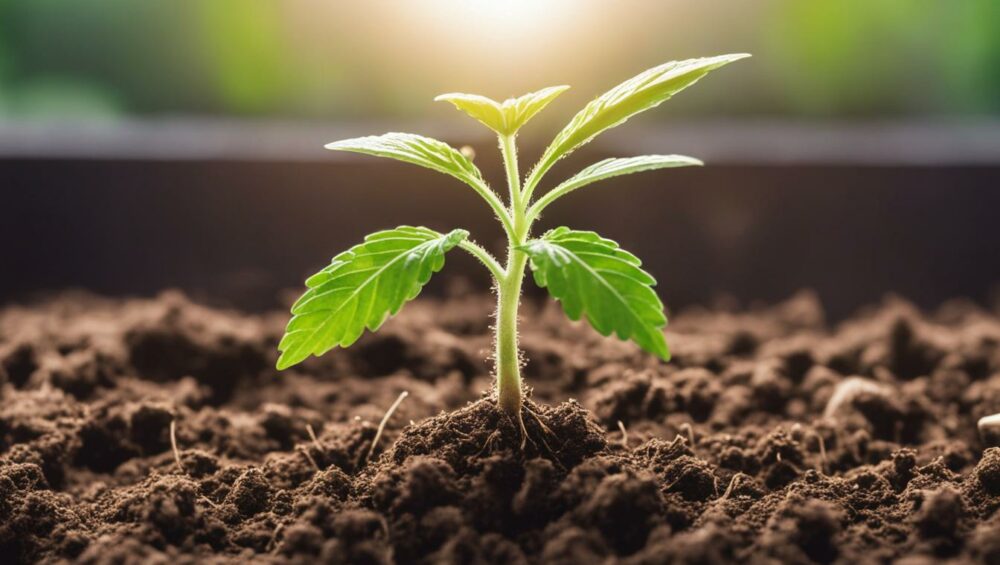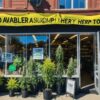Welcome to our comprehensive guide on cultivating CBD flower, from growth to harvest. Whether you’re a seasoned farmer or just starting in the world of CBD cultivation, this guide will provide you with valuable insights and tips to maximize your harvest. With the demand for CBD flower on the rise, it’s essential to cultivate high-quality crops that meet market expectations.
In recent years, the CBD industry has faced challenges, including a decline in hemp production and an oversupply of CBD, resulting in a price plunge. However, by implementing strategic solutions such as focusing on food from grain, advocating for government incentives, and driving structural changes, growers can overcome these obstacles and thrive in the market.
To ensure a successful harvest, having a detailed plan is crucial. This plan should include pruning excess foliage, reducing watering before harvest, minimizing touches and transfers, using modular dry carts, weighing quality against output, preventing mold growth, maintaining a controlled drying environment, and tracking moisture content and water activity.
By following these best practices, you’ll be well-equipped to navigate the cultivation process and achieve a bountiful and high-quality CBD flower harvest. So let’s dive in and explore the essential steps to cultivating CBD flower, from growth to harvest!
Avoiding Harvesting Blunders
In 2022, the hemp industry experienced a significant decline in value, with a 71% decrease compared to the previous year. This drop can be attributed to a decrease in all-purpose harvested hemp, exacerbated by an oversupply of CBD and regulatory challenges. The resulting price plunge has had a substantial impact on hemp production.
As farmers strive to avoid similar harvest blunders, it is essential to explore alternative avenues for hemp cultivation. One such avenue is focusing on food from grain, which diversifies revenue streams and minimizes reliance on CBD alone. Additionally, advocating for government incentives specific to the hemp industry can provide much-needed support to farmers.
Another crucial aspect is pushing for structural changes related to banking and insurance, as these barriers hinder the growth of the industry. By addressing these challenges, farmers can mitigate risks associated with oversupply and establish a more sustainable hemp economy.
Planning for a successful harvest is essential in navigating the ever-changing regulatory landscape. Hemp growers can adopt best practices to optimize their cultivation and preserve the quality of their harvest. These practices include:
- Pruning excess foliage to promote the growth of high-quality flower buds
- Reducing watering before harvest to prevent mold growth and improve drying efficiency
- Minimizing touches and transfers to minimize damage and preserve cannabinoid content
- Using modular dry carts for efficient transportation during the drying process
- Weighing quality against output to maintain consistent standards
- Preventing mold growth by maintaining a controlled drying environment
- Tracking moisture content and water activity to ensure proper drying
Harvesting Best Practices
“Planning for a successful harvest is essential in navigating the ever-changing regulatory landscape.”
Adhering to these best practices will not only contribute to a higher quality harvest but also minimize the risk of blunders that can further contribute to an oversupply of CBD and subsequent price decline. By implementing these strategies, farmers can navigate the challenges of the hemp industry and work towards a more sustainable future.
Comparative Analysis of Hemp Production
| Year | Hemp Production Value (GBP) |
|---|---|
| 2021 | £10,000,000 |
| 2022 | £2,900,000 |
Preparing for the Hemp Harvest
Success in hemp harvest relies on producing a high-quality yield, regardless of the regulatory landscape. This requires careful planning and following best practices.
Planning for Success
To ensure a successful hemp harvest, farmers need to have a detailed plan in place. This plan should encompass various aspects of cultivation, from pruning excess foliage to tracking moisture content and water activity. By having a clear and comprehensive plan, farmers can optimize their harvest and achieve the desired results.
Best Practices for a High-Quality Yield
- Prune excess foliage: Removing unnecessary foliage allows the plant to focus its energy on producing high-quality buds.
- Reduce watering before harvest: Limiting water intake helps prevent overhydration and ensures the plant’s natural compounds are concentrated.
- Minimize touches and transfers: Excessive handling can damage delicate buds and reduce overall yield. Minimizing touches and transfers minimizes the risk of damage.
- Use modular dry carts: Modular dry carts provide an efficient and controlled drying environment, allowing for maximum preservation of quality and potency.
- Weigh quality against output: Prioritize quality over quantity, ensuring that each harvested bud meets the desired standards.
- Prevent mold growth: Mold can significantly impact the quality of the harvest. Implement proper ventilation and humidity control measures to prevent mold growth.
- Maintain a controlled drying environment: Proper drying is crucial to preserve the potency and aroma of the harvested buds. A controlled drying environment ensures optimal conditions.
- Track moisture content and water activity: Monitoring moisture content and water activity levels allows farmers to gauge the readiness of their harvest and prevent issues such as mold or mildew.
Visual Representation of the Pre-harvest Process
| Step | Description |
|---|---|
| Pruning | Remove excess foliage to promote bud development. |
| Watering Reduction | Limit water intake to concentrate natural compounds. |
| Minimize Touches | Handle plants with care to avoid bud damage. |
| Modular Dry Carts | Utilize modular dry carts for controlled drying. |
| Weigh Quality | Prioritize high-quality buds over quantity. |
| Prevent Mold Growth | Implement measures to avoid mold contamination. |
| Controlled Drying Environment | Maintain optimal conditions for drying. |
| Track Moisture Content | Monitor moisture levels to determine readiness for harvest. |
Essential Harvesting Equipment & Processes
In order to achieve a successful hemp harvest, it is crucial for farmers to utilize the right harvesting equipment and implement effective processes. This section will explore the different options available for trimming hemp crops, as well as the essential steps for drying the harvested plants to preserve the terpene profile and quality of the final product.
Trimming Options: Heavy-duty Shears vs Combines
When it comes to trimming hemp crops, farmers have two main options: heavy-duty shears or combines. Each option offers unique benefits and considerations.
- Heavy-duty shears: These tools allow farmers to separate the top of the plant from the stalk, ensuring the preservation of CBD-rich buds. By carefully trimming the plants, farmers can maximize the quality of their harvest and maintain the integrity of the valuable cannabinoid content.
- Combines: Combines offer speed and cost savings, as they can efficiently trim a large volume of hemp crops. However, it’s important to note that combines may result in the shattering of seeds and buds during the trimming process. Farmers should carefully assess the pros and cons of using combines based on their specific needs and objectives.
Drying Techniques: Hanging/Screen-drying and Mechanical Drying
After the harvest, the drying process is vital in order to optimize the terpene profile and overall quality of the hemp. Two common techniques for drying hemp include hanging/screen-drying and mechanical drying.
- Hanging/Screen-drying: This traditional method involves suspending harvested hemp plants on racks, screens, or wires in a controlled environment. Dehumidifiers and fans are typically used to facilitate proper airflow and prevent mold growth. This method allows for gentle drying, preserving the natural flavors and aromas of the hemp.
- Mechanical drying: As the scale of hemp operations increases, farmers may opt for mechanical drying systems. These advanced setups utilize specialized equipment to expedite the drying process. Mechanical drying can offer efficiency and consistency, especially for larger volumes of harvested hemp.

The image above showcases the essential equipment involved in the hemp harvesting process, emphasizing the importance of choosing the right tools for optimal results.
| Harvesting Equipment | Pros | Cons |
|---|---|---|
| Heavy-duty shears | Preserves CBD-rich buds High-quality trimming |
Requires manual labor May be time-consuming for large-scale operations |
| Combines | Speed and cost savings Efficient for large volumes |
Potential shattering of seeds and buds May affect overall quality |
The table above summarizes the pros and cons of the different trimming options available to hemp farmers, providing a clear overview for decision-making.
When it comes to drying techniques, both hanging/screen-drying and mechanical drying have their advantages and considerations, depending on the specific needs and goals of the hemp operation.
| Drying Techniques | Pros | Cons |
|---|---|---|
| Hanging/Screen-drying | Preserve natural flavors and aromas Allows for gentle drying |
Requires controlled environment May be time-consuming |
| Mechanical drying | Efficiency and consistency Suitable for large volumes |
Higher upfront investment May affect taste and quality |
The table above provides an overview of the advantages and considerations for each drying technique, allowing farmers to make informed decisions based on their specific requirements.
Choosing the Right Seeds and Germination
The first step in successful cannabis cultivation is selecting the right seeds. When choosing seeds, growers need to consider crucial factors such as THC and CBD content, as well as the type of plant, whether it is Sativa or Indica-dominant. These considerations will directly impact the quality and characteristics of the final cannabis product.
Once the appropriate seeds have been acquired, the next step is germination. Germination is the process of inducing seeds to sprout and develop into seedlings. This signifies the beginning of the growth cycle. To initiate germination, the seeds are soaked in water, promoting the activation of biochemical changes within the seed.
“Selecting the right seeds is like laying the foundation for a successful cannabis cultivation journey. It is the first step in determining the ultimate quality and attributes of your cannabis plants.” – Expert Grower
After soaking the seeds, they are transferred to a moist paper towel. The moist environment stimulates the internal processes necessary for sprouting. Over time, the seeds will crack open, and tiny rootlets will emerge, initiating the development of seedlings.
Germination is a critical stage that requires careful attention and monitoring. Adequate moisture, temperature, and lighting conditions should be maintained to support the optimal growth of the seedlings. Once the seedlings have established roots and developed a few sets of leaves, they are ready to be transplanted into a suitable growing medium.
Remember, the success of your cannabis cultivation journey starts with selecting the right seeds and understanding the germination process. By ensuring that the seeds are of high quality and providing the ideal conditions for germination, you lay the foundation for healthy and thriving cannabis plants.
Benefits of selecting the right seeds:
- Control over THC and CBD content
- Ability to grow specific cannabis varietals
- Influence on plant size, branching, and overall growth characteristics
Growing tips for successful germination:
- Choose high-quality seeds from reputable sources
- Ensure proper moisture levels during germination
- Maintain an optimal temperature range
- Provide adequate lighting for seedling development
- Transplant seedlings to a suitable growing medium at the right stage
The Seedling Stage to Harvesting
Once the cannabis seeds have germinated, they need to be transferred to a suitable growing medium and placed under suitable light conditions to stimulate growth. As the seedlings progress, they enter the vegetative stage, where their focus shifts towards developing leaves and branches. To facilitate this growth, the plants require an adequate amount of light, an optimal temperature range, and a well-balanced nutritional regimen.
After a few weeks in the vegetative stage, the plants undergo a significant transformation as they transition into the flowering stage. This transition is triggered by changes in the light schedule, typically shifting to a 12-hour light and 12-hour dark cycle. The flowering stage is a critical phase in cannabis cultivation as it is during this time that the plants develop the sought-after flowers containing cannabinoids.
Finally, the time for harvesting the mature cannabis plants arrives, which is determined by observing the appearance of trichomes. These tiny, mushroom-shaped structures on the flowers produce and store the valuable cannabinoids. Growers carefully monitor the trichomes, looking for the optimal time to cut and trim the plants to ensure the highest quality yield.
FAQ
What is the importance of the hemp harvest season, known as “Croptober,” for CBD flower growers?
The hemp harvest season, or “Croptober,” is a crucial time for CBD flower growers as they prepare for sale and maximize their yield.
What challenges has the CBD industry faced in recent times?
The CBD industry has faced challenges including a decline in hemp production and an oversupply of CBD, which has led to a price plunge.
Are there any proposed solutions to overcome these challenges?
Proposed solutions include focusing on food from grain, advocating for government incentives in the hemp industry, and pushing for structural changes.
How can growers ensure a successful harvest?
To ensure a successful harvest, growers should have a detailed plan that includes pruning excess foliage, reducing watering before harvest, minimizing touches and transfers, using modular dry carts, weighing quality against output, preventing mold growth, maintaining a controlled drying environment, and tracking moisture content and water activity.
What led to the decrease in hemp production in 2022?
The value of hemp production in 2022 decreased by 71% compared to 2021 due to a drop in all-purpose harvested hemp. Oversupply of CBD and regulatory challenges contributed to this decline.
How can farmers avoid similar blunders in the future?
Farmers can avoid similar blunders by focusing on food from grain, advocating for government incentives in the hemp industry, and pushing for structural changes to overcome barriers related to banking and insurance.
What are some best practices for a successful hemp harvest?
Best practices for a successful hemp harvest include pruning excess foliage, reducing watering before harvest, minimizing touches and transfers, using modular dry carts, weighing quality against output, preventing mold growth, maintaining a controlled drying environment, and tracking moisture content and water activity.
What role do harvesting equipment and processes play in the success of a hemp harvest?
Harvesting equipment and processes play a crucial role in the success of a hemp harvest. Farmers can choose between heavy-duty shears or combines for trimming hemp crops, and different drying methods can be used depending on the scale of the operation.
How should growers choose the right seeds and initiate the germination process?
The first step in successful cannabis cultivation is selecting the right seeds. Growers need to consider factors such as THC content, CBD content, and the type of plant. The germination process starts by soaking the seeds in water and transferring them to a moist paper towel to trigger sprouting and the development of seedlings.
What are the stages in cannabis cultivation from seedling to harvest?
The stages in cannabis cultivation from seedling to harvest include the seedling stage, vegetative stage, and flowering stage. Each stage requires specific conditions and care to ensure optimal growth and the development of cannabinoids.
How can growers determine the optimal time for cutting and trimming during the harvest?
The optimal time for cutting and trimming during the harvest is determined by the appearance of trichomes, which indicate the peak cannabinoid production in the flowers.







